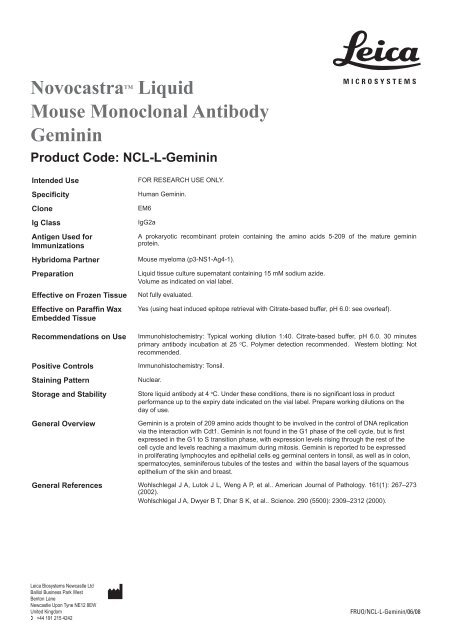Novocastratm Liquid Mouse Monoclonal Antibody Geminin
Novocastratm Liquid Mouse Monoclonal Antibody Geminin
Novocastratm Liquid Mouse Monoclonal Antibody Geminin
You also want an ePaper? Increase the reach of your titles
YUMPU automatically turns print PDFs into web optimized ePapers that Google loves.
Novocastra TM <strong>Liquid</strong><br />
<strong>Mouse</strong> <strong>Monoclonal</strong> <strong>Antibody</strong><br />
<strong>Geminin</strong><br />
Product Code: NCL-L-<strong>Geminin</strong><br />
Intended Use<br />
Specificity<br />
Clone<br />
Ig Class<br />
Antigen Used for<br />
Immunizations<br />
Hybridoma Partner<br />
Preparation<br />
Leica Biosystems Newcastle Ltd<br />
Balliol Business Park West<br />
Benton Lane<br />
Newcastle Upon Tyne NE12 8EW<br />
United Kingdom<br />
( +44 191 215 4242<br />
FOR RESEARCH USE ONLY.<br />
Human <strong>Geminin</strong>.<br />
EM6<br />
IgG2a<br />
A prokaryotic recombinant protein containing the amino acids 5-209 of the mature geminin<br />
protein.<br />
<strong>Mouse</strong> myeloma (p3-NS1-Ag4-1).<br />
Effective on Frozen Tissue Not fully evaluated.<br />
Effective on Paraffin Wax<br />
Embedded Tissue<br />
Recommendations on Use<br />
Positive Controls<br />
Staining Pattern<br />
Storage and Stability<br />
General Overview<br />
General References<br />
<strong>Liquid</strong> tissue culture supernatant containing 15 mM sodium azide.<br />
Volume as indicated on vial label.<br />
Yes (using heat induced epitope retrieval with Citrate-based buffer, pH 6.0: see overleaf).<br />
Immunohistochemistry: Typical working dilution 1:40. Citrate-based buffer, pH 6.0. 30 minutes<br />
primary antibody incubation at 25 o C. Polymer detection recommended. Western blotting: Not<br />
recommended.<br />
Immunohistochemistry: Tonsil.<br />
Nuclear.<br />
Store liquid antibody at 4 o C. Under these conditions, there is no significant loss in product<br />
performance up to the expiry date indicated on the vial label. Prepare working dilutions on the<br />
day of use.<br />
<strong>Geminin</strong> is a protein of 209 amino acids thought to be involved in the control of DNA replication<br />
via the interaction with Cdt1. <strong>Geminin</strong> is not found in the G1 phase of the cell cycle, but is first<br />
expressed in the G1 to S transition phase, with expression levels rising through the rest of the<br />
cell cycle and levels reaching a maximum during mitosis. <strong>Geminin</strong> is reported to be expressed<br />
in proliferating lymphocytes and epithelial cells eg germinal centers in tonsil, as well as in colon,<br />
spermatocytes, seminiferous tubules of the testes and within the basal layers of the squamous<br />
epithelium of the skin and breast.<br />
Wohlschlegal J A, Lutok J L, Weng A P, et al.. American Journal of Pathology. 161(1): 267–273<br />
(2002).<br />
Wohlschlegal J A, Dwyer B T, Dhar S K, et al.. Science. 290 (5500): 2309–2312 (2000).<br />
FRUO/NCL-L-<strong>Geminin</strong>/06/08
Instructions for Use<br />
Heat Induced Epitope Retrieval<br />
Combined With Polymer Detection For<br />
Immunohistochemical Demonstration<br />
On Paraffin Sections<br />
1. Cut and mount sections on slides coated with a suitable tissue adhesive.<br />
2. Deparaffinize sections and rehydrate to distilled water.<br />
3. Place sections in 0.5% hydrogen peroxide/methanol for 10 minutes (or use other appropriate endogenous peroxidase blocking<br />
procedure). Wash sections in tap water.<br />
4. Heat 1500 mL of the recommended epitope retrieval solution (Citrate based pH 6.0 - Epitope Retrieval Solution unless otherwise<br />
indicated overleaf) in a stainless steel pressure cooker until boiling. Cover but do not lock lid.<br />
5. Position slides into metal staining racks (do not place slides close together as uneven staining may occur) and lower into pressure<br />
cooker ensuring slides are completely immersed in epitope retrieval solution. Lock lid.<br />
6. When the pressure cooker reaches operating temperature and pressure (after about 5 minutes) start a timer for 1 minute (unless<br />
otherwise indicated on the data sheet).<br />
7. When the timer rings, remove pressure cooker from heat source and run under cold water with lid on. DO NOT OPEN LID UNTIL<br />
THE INDICATORS SHOW THAT PRESSURE HAS BEEN RELEASED. Open lid, remove slides and place immediately into a bath<br />
of tap water.<br />
8. Wash sections once using fresh Tris-Buffered Saline (TBS, pH 7.6) buffer for 5 minutes.<br />
9. Place sections in diluted normal serum (eg NCL-G-SERUM) for 10 minutes.<br />
10. Incubate sections with primary antibody.<br />
11. Wash twice, each time using fresh TBS buffer for 5 minutes.<br />
12. For visualization of the bound primary antibody, follow instructions supplied with the Polymer Detection System.<br />
13. Counterstain with hematoxylin (if required), dehydrate and mount.<br />
* (In most applications, Phosphate Buffered Saline, pH 7.6, can be used instead of TBS, pH 7.6).<br />
Safety Note<br />
To ensure the correct and safe use of your pressure cooker, PLEASE READ THE MANUFACTURER’S INSTRUCTIONS.<br />
protocol/RUO/HIER+Polymer/04/08<br />
www.leica-microsystems.com © Leica Microsystems GmbH • HRB 5187 • 95.8146 Rev A

















